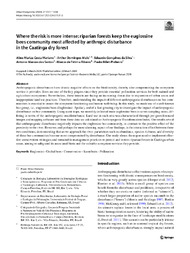Where the risk is more intense: riparian forests keep the euglossine bees community most affected by anthropic disturbance in the Caatinga dry forest.
Where the risk is more intense: riparian forests keep the euglossine bees community most affected by anthropic disturbance in the Caatinga dry forest.
Author(s): MARIANO, A. M. C.; MELO, A. D.; SILVA, E. G. da; SANTOS, A. M. dos; RIBEIRO, M. de F.; PINHEIRO, P. M.
Summary: Anthropogenic disturbances have drastic negative effects on the biodiversity, thereby also compromising the ecosystem service it provides. Bees are one of the key players since they provide essential pollination services for both natural and agriculture ecosystems. Nevertheless, these insects are facing an increasing threat due to expansion of urban areas and inappropriate land use practices. Therefore, understanding the impact of different anthropogenic disturbances on bee communities is essential to assure the ecosystem functioning and human well-being. In this study, we made use of a well-known bee group, i.e., euglossine bees (Euglossine: Apidae), and of a fast-growing city to investigate the impact of anthropogenic disturbance on bee community. Using scent traps, we monthly collected male euglossine bees in seven sampling areas, differing in terms of the anthropogenic use/disturbance. Land use in each area was characterized through pre-georeferenced images and mapping software and from these data we calculated an Anthropogenic Transformation Index. Our results reveal that anthropogenic disturbance negatively impacts the euglossine bee community, in contrast to the positive effect of the proximity to the river. However, and perhaps the most alarming aspect of our findings, is the interaction effect between these two conditions, demonstrating that as we approach the river, parameters such as abundance, species richness, and diversity of these bee communities become more compromised by disturbance. Our study shows the urgent need to implement effective conservation strategies and sustainable management practices to protect and restore riparian forests in Caatinga urban areas, aiming to safeguard its associated biota and the valuable ecosystem services they provide.
Publication year: 2024
Types of publication: Journal article
Unit: Embrapa Semi-arid Region
Observation
Some of Embrapa's publications are published as ePub files. To read them, use or download one of the following free software options to your computer or mobile device. Android: Google Play Books; IOS: iBooks; Windows and Linux: Calibre.
Access other publications
Access the Agricultural Research Database (BDPA) to consult Embrapa's full library collection and records.
Visit Embrapa Bookstore to purchase books and other publications sold by Embrapa.

